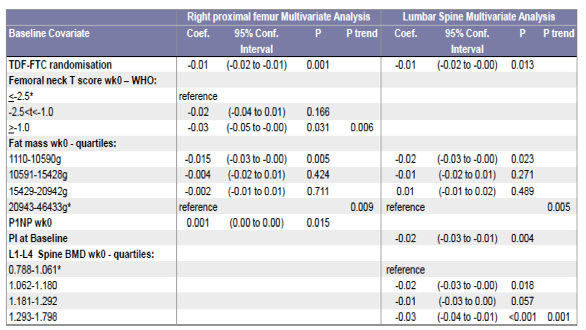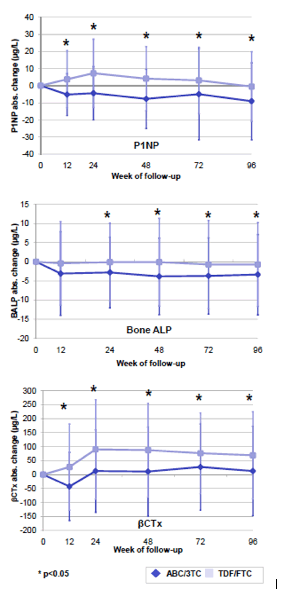 |
 |
 |
| |
STEAL Study 2 Yrs Followup: Tenofovir Speeds BMD Loss vs Abacavir, But Does Not Raise Fracture Risk Over 2 Years Followup; Lower Fat Mass Also Predicts Bone Loss
|
| |
| |
6th IAS Conference on HIV Pathogenesis, Treatment and Prevention, July 17-20, 2011, Rome
Authors: "Predictors of BMD change (Table2): Independent baseline predictors of greater bone loss from both the femoral (FN) neck and spine were tenofovir randomization (p≤0.013), lower fat mass (p-trend≤0.005), lower P1NP (bone marker) (p=0.015), and higher FN T score/spine BMD (p-trend≤0.006)."
"Early changes in BTM (baseline to week 12) did not predict bone loss at week 96."
"TDF/FTC increased bone formation (P1NP,BALP) and resorption (βCTx) markers through week 96 (Figure1)."
Mark Mascolini
Compared with abacavir, tenofovir for 96 weeks increased bone turnover and spine and hip bone mineral density (BMD) loss in the randomized STEAL trial [1]. But after 2 years of follow-up, the tenofovir and abacavir groups did not differ in 10-year fracture risk or in the proportion of people who met US National Osteoporosis Foundation guidelines for antiresorptive therapy. The findings come from a study group consistently almost entirely of white men averaging 45 years in age. The authors's title for the poster is "Lower Fat Mass & Lower Bone Formation Predict Greater Bone Loss with Tenofovir in HIV-Infected Adults".
The STEAL study randomized 357 antiretroviral-experienced people to simplify the backbone of their current regimen to fixed-dose tenofovir/emtricitabine (TDF/FTC) or fixed-dose abacavir/lamivudine (ABC/3TC) [2]. After 96 weeks, BMD decreased significantly more in people randomized to TDF/FTC than to ABC/3TC. But people randomized to TDF/FTC had significantly fewer serious non-AIDS events than those randomized to ABC/3TC.
To take a closer look at factors that may predict BMD loss, STEAL investigators analyzed bone turnover markers at study weeks 0, 12, 24, 48, 72, and 96. They estimated 10-year fracture risk with the FRAX UK algorithm, and they recorded the proportions in each study arm who met US National Osteoporosis Foundation guidelines for antiresorptive therapy to remedy BMD loss.
This analysis involved 154 people in the TDF/FTC group and 147 in the ABC/3TC group. Most study participants (98%) were men, 85% were Caucasian, age averaged 45 years, and initial CD4 count averaged 604 in the TDF/FTC arm and 623 in the ABC/3TC arm. Body mass index averaged 24.8 kg/m(2) in the TDF group and 24.7 kg/m(2) in the ABC group.
Markers of bone formation (P1NP and BALP) and bone resorption (betaCTx) were significantly higher with TDF than with ABC through 96 weeks. Four study baseline factors independently predicted greater BMD loss in both the femoral neck and spine:
--Randomization to TDF/FTC (P < 0.013)
--Lower fat mass (P < 0.005)
--Lower P1NP (P = 0.015)
--Higher femoral neck T score/spine BMD (P < 0.006)
Changes in bone turnover markers through week 12 did not predict bone loss at 96 weeks. Ten-year FRAX-estimated fracture risk did not differ between the TDF/FTC group and the ABC/3TC group at 96 weeks. Nor did the STEAL team see a significant difference in proportions reaching guideline thresholds for antiresorptive therapy.
Through 96 weeks, there was a trend toward greater incidence of low femoral neck BMD in the TDF/FTC group (-4.8, 95% confidence interval -10.6 to +0.4, P = 0.06) but not in incidence of low spine BMD (-3.6, 95% confidence interval -8.7 to +1.4, P = 0.125).
The STEAL team concluded that "tenofovir treatment, lower bone formation and lower fat mass predicted subsequent bone loss," but "there was no association between tenofovir and fracture risk" through 2 years of follow-up in this largely male, middle-aged population.

Figure1: Mean change from baseline to week 96 in bone turnover markers by randomized arm (there was no difference in changes in bone turnover regulators between treatment groups)

References
1. Haskelberg H, Joy J, Amin J, et al, on behalf of the STEAL Study Group. Lower body fat mass and lower bone formation predict greater bone loss with tenofovir in HIV-infected adults. 6th IAS Conference on HIV Pathogenesis, Treatment and Prevention. July 17-20, 2011. Rome. Abstract TUPE245. http://pag.ias2011.org/EPosterHandler.axd?aid=3050.
2. Martin A, Bloch M, Amin J, Baker D, Cooper DA, Emery S, Carr A. Simplification of antiretroviral therapy with tenofovir-emtricitabine or abacavir-lamivudine: a randomized, 96-week trial. Clin Infect Dis. 2009;49:1591-1601. http://cid.oxfordjournals.org/content/49/10/1591.long.
|
| |
|
 |
 |
|
|